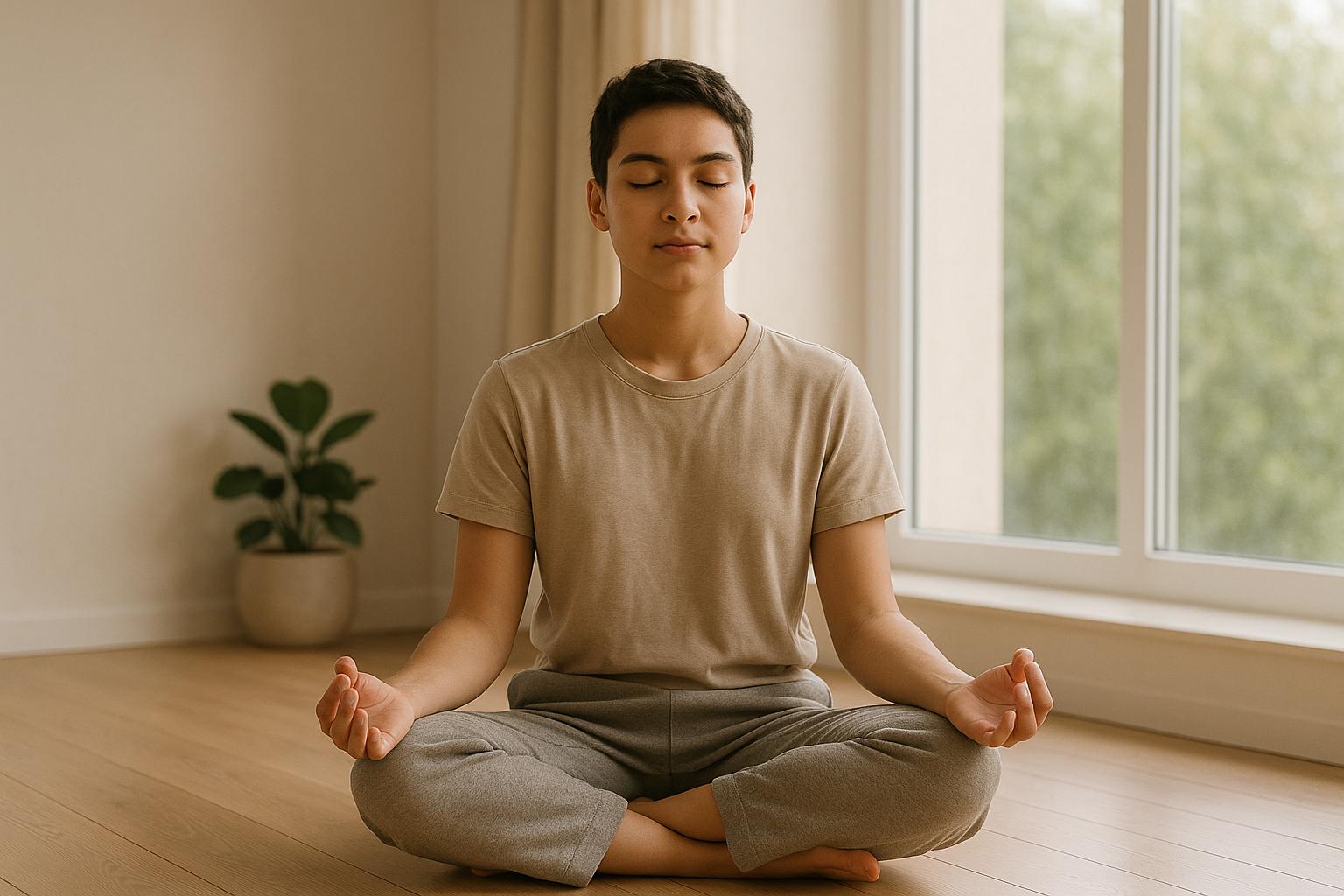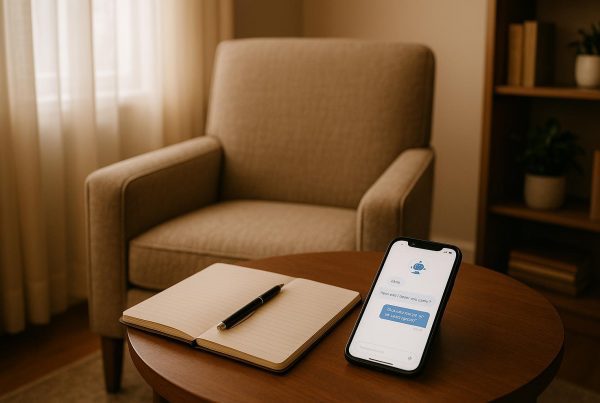Mindfulness can sharpen your focus and improve how your brain works. Here’s why it matters and how to start:
- Why It’s Important: Research shows our minds wander about 47% of the day, disrupting focus and decision-making. Mindfulness helps regain control.
- What It Does: Regular mindfulness strengthens brain areas tied to attention, memory, and emotional regulation. Studies confirm it improves mood, reduces stress, and even enhances memory retention.
- How It Works: Mindfulness reshapes the brain through neuroplasticity, improving neural connections, calming stress responses, and increasing grey matter density.
- Easy Ways to Start:
- Focus on your breath (e.g., 4-7-8 breathing).
- Practice body awareness with a body scan.
- Observe your thoughts without judgment.
Tools like Aidx.ai can guide you with personalized sessions and track your progress. Even just a few minutes a day can make a big difference.
Brain Science Behind Mindfulness
How Mindfulness Changes the Brain
Practicing mindfulness meditation regularly doesn’t just help you feel calmer – it actually reshapes your brain. Studies show it physically alters areas responsible for attention, emotional regulation, and self-awareness [3].
Here’s how these changes happen:
- Improved neural connections: Mindfulness enhances communication between different brain regions.
- Neurotransmitter adjustments: It influences systems like GABA and serotonin, which play roles in mood and relaxation.
- Increased grey matter density: Key areas for learning and memory show structural growth.
- Calmer stress response: The amygdala, the brain’s stress hub, becomes less reactive and even shrinks in size [3].
These transformations highlight the brain’s ability to adapt through mindfulness, a concept known as neuroplasticity. In fact, a 2011 study found that just eight weeks of mindfulness practice led to measurable increases in grey matter density, proving how quickly the brain can respond to mental training [4].
Brain Areas Improved by Mindfulness
Mindfulness doesn’t just benefit the mind – it targets specific brain regions that drive our cognitive abilities and emotional balance:
Prefrontal Cortex and Anterior Cingulate Cortex (ACC)
These areas are the command centers for decision-making, attention, and impulse control. Regular mindfulness practice thickens the cortex in these regions, sharpening focus and improving emotional regulation [2].
Insula and Precentral Gyrus
The right insula, which governs self-awareness, becomes more active during mindfulness exercises. Similarly, the precentral gyrus, tied to attention, shows increased engagement during sustained focus tasks [2].
Hippocampus
Known as the brain’s memory hub, the hippocampus undergoes structural changes that enhance information processing and memory retention with consistent mindfulness practice [2].
Scientific Study Results
The science behind mindfulness is extensive, with research consistently demonstrating its positive effects on brain function. A review of more than 200 studies highlighted its success in reducing stress, anxiety, and depression [5].
Here are some standout findings:
- Sustained attention: Older adults who practiced mindfulness for eight weeks experienced noticeable improvements in attention, with benefits lasting for at least six months [1].
- Pain relief: Mindfulness reduced pain intensity more effectively than placebo treatments by activating specific brain pathways [2].
- Enhanced brain efficiency: It boosts both "bottom-up" sensory processing and "top-down" attention control, improving how the brain handles information [1].
These discoveries show how mindfulness can be a powerful tool for sharpening focus and improving overall cognitive performance.
3 Core Mindfulness Methods for Better Focus
Breath Focus Exercise
The breath focus exercise is a simple yet powerful way to sharpen your concentration. Dr. Ronald D. Siegel, assistant clinical professor of psychology at Harvard Medical School, puts it well:
"Learning to focus attention and relax is a skill. As with any skill, your ability to focus and relax will improve with practice" [7].
Here’s how you can practice breath meditation step by step:
- Find Your Space: Sit comfortably in a quiet place where you won’t be disturbed [6].
- Focus on Breathing: Close your eyes and pay attention to your natural breath. Feel the air as it moves through your nostrils, notice the rise and fall of your chest, and sense the movement in your abdomen [6].
- Try 4-7-8 Breathing: Add this rhythmic breathing technique for deeper relaxation:
- Inhale through your nose for 4 seconds.
- Hold your breath for 7 seconds.
- Exhale slowly through your mouth for 8 seconds [6].
Research from 2006 shows that just 15 minutes of focused breathing can significantly reduce negative emotions [8].
Body Awareness Practice
Once you’re comfortable with breath-focused exercises, you can move on to body awareness. This practice helps you tune into physical sensations and develop a deeper connection with your body [9].
Start with a body scan:
- Set the Scene: Find a quiet spot and sit or lie down in a comfortable position [9].
- Scan Your Body:
- Begin by focusing on your feet. Notice any sensations like warmth, pressure, or tingling.
- Gradually shift your attention upward, moving through each part of your body.
- Pay special attention to areas of tension, and use your breath to gently release it [9].
As one expert notes:
"The goal is not to relieve the pain entirely but to get to know and learn from it so you can better manage it" [10].
Thought Observation Technique
After grounding yourself with breath and body awareness, the next step is observing your thoughts. This technique helps you clear mental clutter and develop a more objective perspective on your inner dialogue [11].
Key principles include:
- Recognizing thoughts as passing mental events, not absolute truths.
- Watching your thoughts come and go, like clouds drifting across the sky.
- Avoiding judgment – just observe without attaching meaning.
- Redirecting your focus to the present moment whenever you get caught up in a thought.
"A thought is not a fact – a thought is just a thought" [12].
Getting Started:
- Begin with short, 5-minute sessions.
- Use visual metaphors, like picturing thoughts as clouds or words written on water.
- Notice patterns in your thinking and gently return to observing when you get distracted.
Solutions to Common Mindfulness Obstacles
Managing Distraction and Restlessness
Distractions and restlessness are a normal part of practicing mindfulness [13]. Instead of seeing them as setbacks, think of these moments as chances to build your ability to refocus.
Start by silencing your devices and picking a quiet time and place for your practice. If background noise is unavoidable, consider using noise-canceling headphones or choosing quieter periods like early mornings or late evenings. When your thoughts stray, simply notice the distraction without judging yourself, and gently bring your attention back to your breath or body sensations [13][14].
Building a Regular Practice
Establishing a consistent routine is essential for developing mindfulness skills. Here are some practical tips to help you stick with it:
- Find a specific time and space for your practice.
- Use visual reminders, like sticky notes, to prompt you.
- Incorporate mindfulness into daily tasks such as eating, showering, or walking [15].
Short, regular sessions often yield better results than sporadic, longer ones [16].
Measuring Your Progress
Tracking your mindfulness journey can keep you motivated and highlight areas for improvement. Studies show that the first 500 hours of practice often lead to noticeable psychological benefits [18].
Here are some useful metrics to monitor:
- Time spent in formal practice.
- Mood changes before and after sessions.
- Shifts in attention span.
- Variations in stress levels.
- Improvements in sleep patterns.
A simple way to track progress might look like this:
| Metric | Tool | Frequency |
|---|---|---|
| Practice Duration | Timer or meditation app | Daily |
| Emotional State | 1-10 scale rating | Before & after |
| Focus Quality | Journal entry | Post-session |
| Stress Levels | Weekly reflection | Every 7 days |
sbb-itb-d5e73b4
How Meditation Actually Changes Your Brain (Backed by Science!)
Using AI Tools for Mindfulness Practice
AI-powered tools are making mindfulness more accessible than ever. These tools provide consistent guidance and accurate progress tracking, helping users stick to their routines and refine their techniques. By combining voice guidance with real-time feedback, they create an environment where mindfulness practices can truly thrive.
Guided Voice Mindfulness with Aidx.ai

Aidx.ai offers a hands-free, natural approach to mindfulness. Its Adaptive Therapeutic Intelligence (ATI) System™ tailors sessions to your personal needs, adapting as you progress [19].
The platform includes specialized modes such as:
- Microcoaching Mode: Quick, focused 5-minute sessions.
- Embodiment Mode: Helps you visualize and deepen mindful states.
- Default Mode: Combines techniques from CBT, DBT, and ACT for a comprehensive experience.
"My experience with aidx was impressive, it offered great support and ideas, was able to have fluent conversations, on top of that it checked in with me… it is a brilliant tool for anyone who needs support quickly. It is truly game changing and will shake the industry very quickly." – Salvija, Abuse Expert and Clinical Hypnotherapist [19]
Tracking Focus and Progress
Aidx.ai also excels at tracking your mindfulness journey. It monitors:
- Emotional states before and after sessions.
- Improvements in attention span.
- Stress reduction over time.
- Consistency in your practice.
These insights not only highlight your progress but also pinpoint areas where you can improve [19].
Daily Mindfulness Reminders
To keep your mindfulness practice on track, Aidx.ai uses a multi-channel notification system for daily prompts and updates:
| Reminder Type | Delivery Method | Purpose |
|---|---|---|
| Practice Alerts | Push notifications | Remind you to complete daily sessions |
| Progress Updates | Provide weekly summaries of progress | |
| Check-ins | Telegram/WhatsApp | Offer real-time support |
Interestingly, studies show that 75% of people are open to AI-driven mental health support [19]. With features like voice-guided sessions, detailed tracking, and timely reminders, tools like Aidx.ai help users stay focused and achieve their mindfulness goals effectively.
Conclusion: Making Mindfulness Work for You
Mindfulness isn’t just about relaxation – it’s a way to sharpen your focus and enhance how your brain processes information. Studies show that consistent mindfulness practice strengthens the brain’s pathways for processing sensory input and improves attention control [1]. If you’re ready to bring mindfulness into your life, there are simple steps to get started.
Here are a few ways to build your practice:
- Pick a focus point: This could be your breath, the sounds around you, or even how your body feels in the moment [17].
- Start small: Just 2–3 minutes a day is plenty to begin with [20].
- Tie it to your routine: Pair mindfulness with daily habits, like sipping your morning coffee or during your commute [21].
- Try Aidx.ai: This tool offers guided sessions, tracks your progress, and helps you stay consistent [19].
What matters most is consistency. Progress isn’t about perfection but about recognizing when your mind has wandered and gently bringing it back to the present. Mix structured practices with casual mindful moments throughout your day to make mindfulness a natural part of your routine. Over time, you’ll notice stronger focus and sharper cognitive skills, benefiting both your personal life and your work.
FAQs
How long does it take for mindfulness to improve brain function?
Research indicates that practicing mindfulness can bring about visible changes in both brain function and structure in just eight weeks. Studies have shown that consistent mindfulness practice enhances memory, emotional regulation, and self-awareness. For instance, setting aside around 27 minutes daily for mindfulness meditation has been linked to noticeable benefits. With steady commitment, many individuals report cognitive and emotional improvements in a matter of weeks, proving mindfulness to be an effective approach for boosting mental performance and overall well-being.
What challenges do beginners face with mindfulness, and how can they overcome them?
Starting a mindfulness practice can feel tricky, especially for beginners. It’s common to face challenges like doubts, restlessness, and irritation. Many wonder if mindfulness will actually work for them, which can make sticking with it harder. When these doubts creep in, try to recognize them as temporary thoughts. Then, gently guide your attention back to the practice.
Restlessness is another hurdle, and it’s completely normal. Our minds are naturally active, so instead of pushing against that energy, simply notice it without judgment. If sitting still feels too much, you might find mindful movement – like walking meditation – a helpful alternative to ease into the process. Irritation can also pop up, whether it’s from distractions or unmet expectations. The key is to accept these emotions as part of the journey and remind yourself that mindfulness is about observing your feelings, not resisting them.
Over time, with patience and steady effort, these challenges often fade, making room for a more fulfilling mindfulness practice.
How does mindfulness improve attention and cognitive skills?
Mindfulness helps sharpen your attention and cognitive abilities by anchoring you in the present moment. This practice not only improves focus but also enhances your ability to adapt and think creatively. Studies show that regular mindfulness exercises, such as meditation, can actually increase gray matter in brain areas tied to memory, learning, and decision-making. The result? Better working memory and stronger executive function.
What sets mindfulness apart from other mental exercises is its impact on metacognitive awareness – your ability to observe thoughts without getting tangled in them. This skill reduces distractions, boosts selective attention, and may even slow age-related cognitive decline. It’s a practical way to cultivate mental clarity and strengthen your resilience for life’s challenges.



